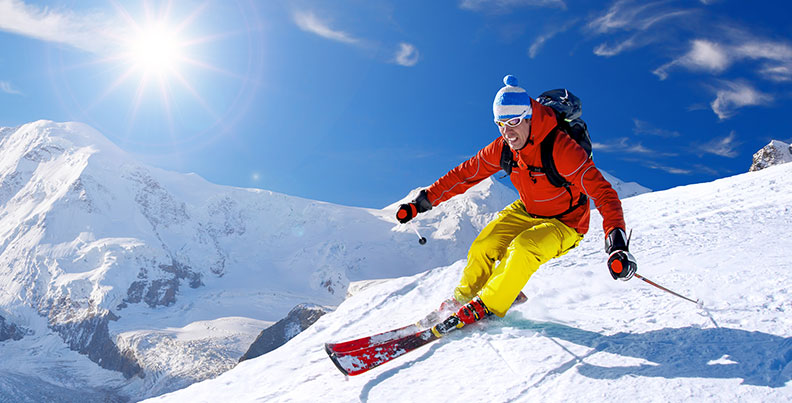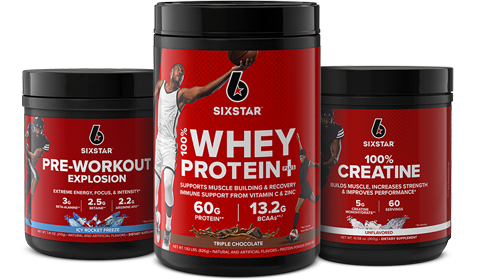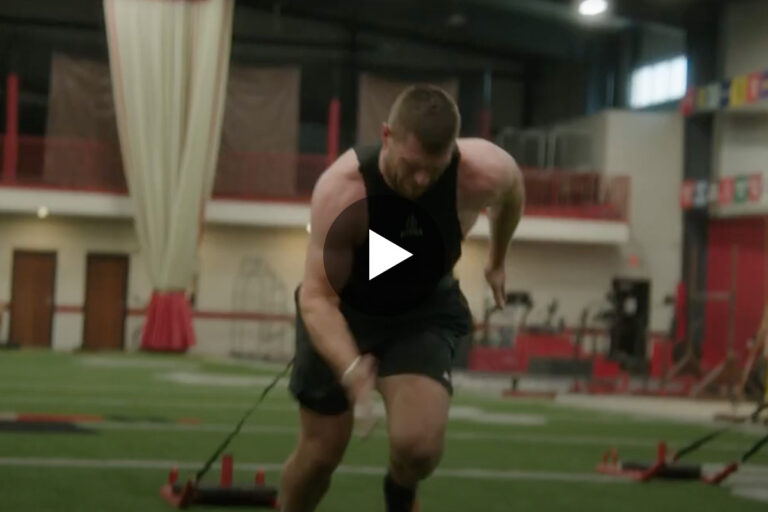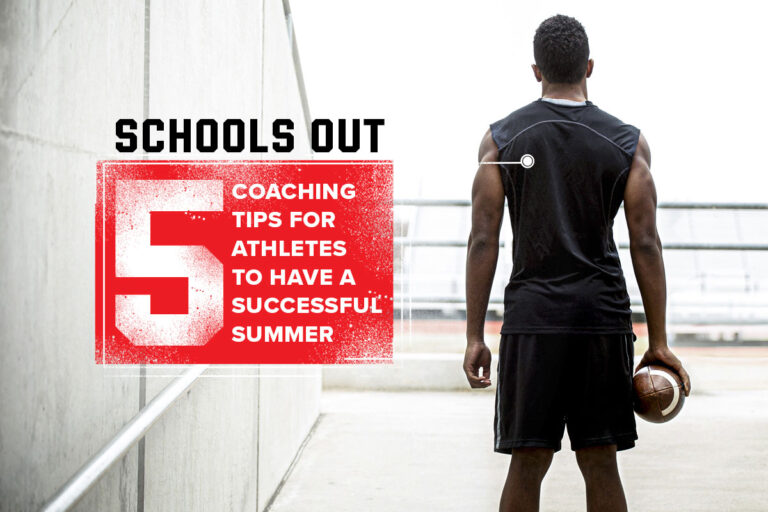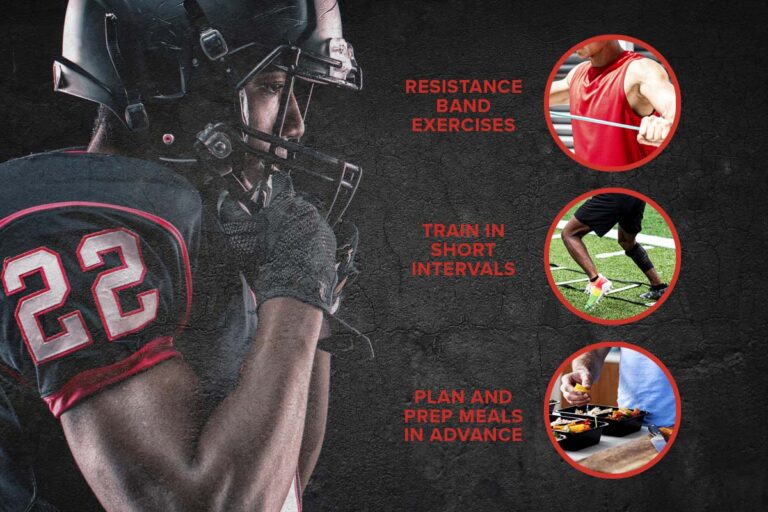Staying fit during the winter months can certainly be challenging. The temperature drops dramatically in a lot of places, it gets dark early, and inclement weather may prevent you from heading outdoors for a workout, or even close your gym if there’s a severe winter snowstorm. Missing the occasional workout here and there isn’t that big of a deal, but if you decide to cozy up indoors this winter and not workout, you run the risk of losing all the endurance and/or strength that you’ve built up this year within one to three months of not exercising.
“The benefits of exercise don’t fade away with the summer sun. If you let your workout routines lapse, you’re going to be stuck with weeks or months of recovery work in spring, increasing your injury risk and slowing any progress toward fitness goals,” according to a Business Insider article. “If anything, winter is perhaps when we could most use the stress-reducing and mental health-improving benefits of exercise.”
We know the holidays can wreak havoc on your exercise routine for a variety of reasons, but any workouts you can get in this November and December will give you a much needed edge when it comes following through with your workouts this winter. December is said to be the best time to get used to exercising outdoors since it’s cold, but not unbearable. So, if you’re able to make it through your outdoor workouts in December, you stand a much better chance of sticking with them when the weather gets much colder and less tolerable in January and February.
It’ll also helps if you have a reason to head outdoors this winter. We’ll take you through the best winter sports for staying fit in hopes that you’ll find one that’ll be a perfect match for you.
DOWNHILL SKIING
“Skiing gets you outdoors in the winter when we often end up on the couch or are passive,” says physical therapist Scott Tremmel in a Cleveland Clinic article. “We’re just not as active when the cold weather sets in, but skiing keeps you moving to continue to build up your endurance.”
Tremmel says that one of the advantages of downhill skiing is that it’s something you can do for several hours at a time, while strengthening both your large- and small-muscle groups including your quadriceps, hamstrings, gluteals, core, and upper body. It may also help improve your mood and emotional health, in addition to your physical health.
“When you’re skiing, you’re often out with a group of friends and you’re socializing,” Tremmel says. “You’re getting fresh air and taking in the beautiful scenery around you. It’s good for your emotional health.”
UPHILL SKIING (AKA SKINNING OR ALPINE TOURING)
“Uphill skiing – better known as skinning or alpine touring – involves adhering nylon material, known as skins, to the base of skis, enabling skiers to ascend without sliding backward,” according to The New York Times. “The appeal is a combination of cardio fitness, the satisfaction that comes from ascending on your own power without the purchase of a lift ticket, and for those in the backcountry, connecting with nature and escaping the ski-resort crowd.”
Uphill skiing or skinning works your hamstrings, glutes, and quads with each step, as well as your arms, shoulders, and upper back because you’re using the poles, according to Women’s Health. You can burn around 750 to 1,080 calories per hour when uphill skiing or skinning.
CROSS-COUNTRY SKIING
“Cross-country skiing recruits your legs, quads, and glutes,” says Wayne Westcott, Ph.D., C.S.C.S, professor of exercise science at Quincy College, in a Women’s Health article. “And because you’re pushing off the ground with each step, you’re using the abductors on your outer thighs, too, which you wouldn’t work running or riding a bike. You’re also working your shoulders, triceps, biceps, and upper back by using the poles to help you propel forward.”
The sport also works your core muscles and obliques, and at a high-intensity you can burn 750 to 1,050 calories per hour cross-country skiing.
SNOWBOARDING
“With snowboarding, you can get outdoors and stay fit during the winter months, which is a pretty good reason for you to head to the mountains and grab a board,” according to Health Fitness Revolution. “Snowboarding can help squash winter boredom and inactivity, while providing a myriad of physical and mental benefits.”
Some of the benefits that snowboarding has to offer are muscle training, increasing flexibility, improving balance and coordination, engaging core muscles, boosting your mood, and helping to reduce stress and anxiety. You can also burn up to 450 calories per hour snowboarding.
ICE SKATING
“It has cardiovascular benefits as it trains both your aerobic and anaerobic systems, and it’s a fantastic overall body challenge to your core, your balance, your coordination, and your posterior chain,” says Peter Zapalo, the director of sports science and medicine for U.S. Figure Skating in a Vogue “Skip the Gym and Hit the Ice: Why Skating Is the Best Winter Workout” article. “Also: Skaters have great butts. But the really cool thing is that [the sport] trains total body proprioception – the ability to sense your own body’s position, motion, and equilibrium.”
To get your heart pumping, Active recommends skating as fast as you can for 30 feet, coming to a complete stop and touching the ice with your hand, and then hurrying back to your starting point and touching the ice again. You can do this for one minute, three times, and then skate at a leisurely pace for a minute or two to catch your breath. You can also change your distance, reduce your rest time, and try going for longer periods as you become a stronger skater and build your endurance.
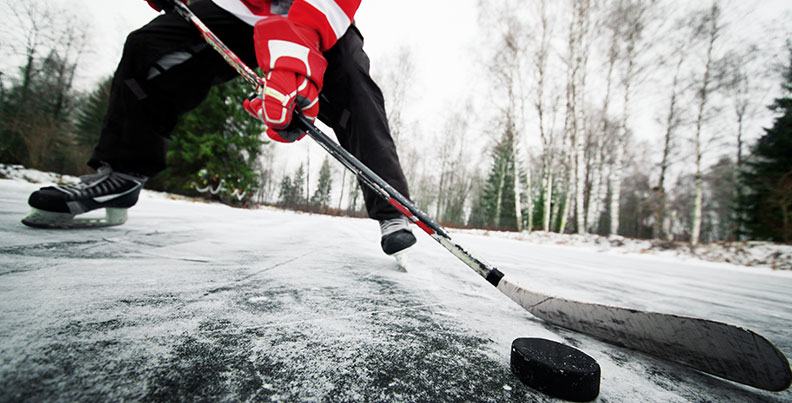
ICE HOCKEY
“Hockey is a sport that offers a total-body workout that includes both aerobic and anaerobic elements,” according to SportsRec. “The fast-paced nature of the sport provides aerobic exercise, while the reliance on all of the body’s major muscle groups also makes it an anaerobic activity.”
Ice hockey offers a number of physical and mental health benefits including enhanced strength, improved coordination and balance, and a boost to your brain, according to SportsRec.
“As a winter exercise, ice hockey has similar benefits to ice skating,” according to an Everyday Health article. “Figure about 200 calories for a 20-minute period if you weigh about 150 pounds.”
SNOWSHOEING
Snowshoeing is considered a wilder, more adventurous version of hiking, which allows you to get out in the winter and explore. It works your hips, glutes, hamstrings, and quads.
“It’s great for people who are uncoordinated,” says Al Sochard, a facilities director at Camp Newfound-Owatonna, in a Men’s Health article. “Unlike with skiing, there isn’t a learning curve and you don’t have to worry about crashing into a tree.”
Snowshoeing is also fairly easy to learn since it’s generally no different than walking. At a high-intensity, you can burn between 570 to 840 calories per hour snowshoeing.
“In deeper snow and when you’re moving uphill or downhill, you want to take heavier, more confident steps,” according to Men’s Health. “But be sure to test your footing so the snow doesn’t collapse under your weight, even with the buoyancy the shoes provide. Bring a small backpack with plenty of water.”
CURLING
“Curling, the act of sliding large stones across a sheet of ice towards a target, looks straightforward, but the simple sport can be deceivingly hard to do well,” according to a USA Today article. “It’s similar to golf because it’s a sport that requires much accuracy, but your whole team, from the curler to the sweeper, plays a part in the overall outcome. Since it was included in the Olympics in 1998 curling has become increasingly popular, so it’s easier than ever to find ice – or ‘curling sheets,’ as they’re called officially – to play on.”
Curling requires a lot of strategizing, interval work, and perfect form, according to a Shape article. A typical game lasts for 8 to 10 rounds (or ‘ends’) and can take about 2 ½ hours to complete. While curling, you can usually burn around 270 calories per hour.
SLEDDING
Sledding is an excellent cardio and leg workout that engages your obliques and arms as you steer to go down the hill.
“You may have fond memories of going sledding as a kid, but who says you have to turn in your sled during adulthood?” according to Women’s Health. “Even more compelling: All that trudging up and down a hill in the snow can actually burn around 400 to 600 calories per hour.”
ICE CLIMBING
“Ice climbing is a lot like rock climbing – on ice,” according to Explore-Share. “Rather than climbing on rocky surfaces, ice climbers use crampons, picks, ropes, and other equipment to climb on ice.”
In order to climb safely, Men’s Health recommends hiring a good guide, and making sure that you have all the right gear.
“There’s a good shot you’ll be belaying, which means you’re connected to your guide (and a sturdy rock above) with a rope that’s securely attached to a harness around your waist, so you can climb without fear of falling,” according to Men’s Health. “To climb, you essentially kick each foot into the ice slightly above and in front of you, then swing each axe overhead, hooking into the ice above you to pull yourself up.”
When ice climbing, you’ll be working your forearms, upper body, core, and legs.
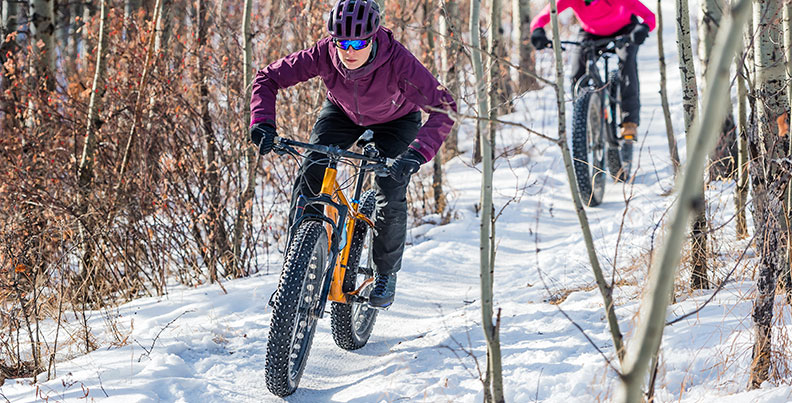
FAT BIKING (OR WINTER MOUNTAIN BIKING)
“By definition, a fat bike is a bicycle with over-sized tires typically from 3.7’’ to 5’’ rims, twice as wide as a standard mountain bike tire,” according to a Runner’s World article. “The fatness is purposeful in that it increases the contact patch on the ground (more tire and traction on the ground), to allow the bike and you, to float over softer terrain like snow, ice, dirt, and sand.”
Depending on the terrain and conditions, some people claim that fat biking in the winter can burn over 1,000 calories per hour.
“Fat biking is to cycling, as trail running is to running – an opportunity to explore off the beaten path and move with the terrain,” according to Runner’s World. “And trail riding is an effective cross-training activity for runners, especially trail runners who need strength, balance, and power to efficiently navigate the uneven terrain.”
TRAIL RUNNING
Trail running works your muscles, tendons, and ligaments different than running on the road or a treadmill. Research has shown that running on trails can burn 10% more calories than running on roads. And regardless of whether you’re running uphill or down, trail running strengthens your quads, glutes, calves, and core.
“Perhaps the most basic rule of winter running is that you should be cold starting out,” according to Trail Runner Magazine. “Your body will warm up significantly within the first mile; if you are comfortable starting out, you will soon find yourself overheating, and dropping a layer, only to doubly freeze in the sweat you’ve accrued.”
As with any other training program, Men’s Journal recommends easing into trail running in order to allow your muscles, joints, and ligaments to gradually and safely become stronger.
